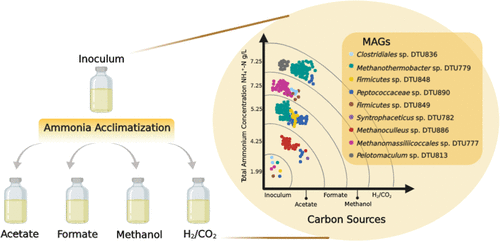当前位置:
X-MOL 学术
›
Environ. Sci. Technol.
›
论文详情
Our official English website, www.x-mol.net, welcomes your
feedback! (Note: you will need to create a separate account there.)
Insights into Ammonia Adaptation and Methanogenic Precursor Oxidation by Genome-Centric Analysis.
Environmental Science & Technology ( IF 10.8 ) Pub Date : 2020-08-27 , DOI: 10.1021/acs.est.0c01945 Miao Yan 1 , Laura Treu 2 , Xinyu Zhu 1 , Hailin Tian 1, 3 , Arianna Basile 2 , Ioannis A Fotidis 1, 4 , Stefano Campanaro 2, 5 , Irini Angelidaki 1
Environmental Science & Technology ( IF 10.8 ) Pub Date : 2020-08-27 , DOI: 10.1021/acs.est.0c01945 Miao Yan 1 , Laura Treu 2 , Xinyu Zhu 1 , Hailin Tian 1, 3 , Arianna Basile 2 , Ioannis A Fotidis 1, 4 , Stefano Campanaro 2, 5 , Irini Angelidaki 1
Affiliation

|
Ammonia released from the degradation of protein and/or urea usually leads to suboptimal anaerobic digestion (AD) when N-rich organic waste is used. However, the insights behind the differential ammonia tolerance of anaerobic microbiomes remain an enigma. In this study, the cultivation in synthetic medium with different carbon sources (acetate, methanol, formate, and H2/CO2) shaped a common initial inoculum into four unique ammonia-tolerant syntrophic populations. Specifically, various levels of ammonia tolerance were observed: consortia fed with methanol and H2/CO2 could grow at ammonia levels up to 7.25 g NH+-N/L, whereas the other two groups (formate and acetate) only thrived at 5.25 and 4.25 g NH+-N/L, respectively. Metabolic reconstruction highlighted that this divergent microbiome might be achieved by complementary metabolisms to maximize biomethane recovery from carbon sources, thus indicating the importance of the syntrophic community in the AD of N-rich substrates. Besides, sodium/proton antiporter operon, osmoprotectant/K+ regulator, and osmoprotectant synthesis operon may function as the main drivers of adaptation to the ammonia stress. Moreover, energy from the substrate-level phosphorylation and multiple energy-converting hydrogenases (e.g., Ech and Eha) could aid methanogens to balance the energy request for anabolic activities and contribute to thriving when exposed to high ammonia levels.
中文翻译:

通过以基因组为中心的分析深入了解氨适应和产甲烷前体氧化。
当使用富含氮的有机废物时,蛋白质和/或尿素降解释放的氨通常会导致厌氧消化(AD)不理想。然而,厌氧微生物组对氨的耐受性差异背后的见解仍然是个谜。在本研究中,在具有不同碳源(乙酸盐、甲醇、甲酸盐和H 2 /CO 2 )的合成培养基中的培养将共同的初始接种物塑造成四种独特的耐氨互养群体。具体而言,观察到不同水平的氨耐受性:用甲醇和 H 2 /CO 2喂养的聚落可以在高达 7.25 g NH + -N/L 的氨水平下生长,而其他两组(甲酸盐和乙酸盐)仅在 5.25 g NH + -N/L 时生长。和 4.25 g NH + -N/L。代谢重建强调,这种不同的微生物组可能是通过互补代谢来实现的,以最大限度地从碳源中回收生物甲烷,从而表明互养群落在富氮底物的 AD 中的重要性。此外,钠/质子逆向转运操纵子、渗透保护剂/K +调节剂和渗透保护剂合成操纵子可能是适应氨胁迫的主要驱动因素。此外,来自底物水平磷酸化和多种能量转换氢化酶(例如Ech和Eha)的能量可以帮助产甲烷菌平衡合成代谢活动的能量需求,并有助于在暴露于高氨水平时蓬勃发展。
更新日期:2020-10-06
中文翻译:

通过以基因组为中心的分析深入了解氨适应和产甲烷前体氧化。
当使用富含氮的有机废物时,蛋白质和/或尿素降解释放的氨通常会导致厌氧消化(AD)不理想。然而,厌氧微生物组对氨的耐受性差异背后的见解仍然是个谜。在本研究中,在具有不同碳源(乙酸盐、甲醇、甲酸盐和H 2 /CO 2 )的合成培养基中的培养将共同的初始接种物塑造成四种独特的耐氨互养群体。具体而言,观察到不同水平的氨耐受性:用甲醇和 H 2 /CO 2喂养的聚落可以在高达 7.25 g NH + -N/L 的氨水平下生长,而其他两组(甲酸盐和乙酸盐)仅在 5.25 g NH + -N/L 时生长。和 4.25 g NH + -N/L。代谢重建强调,这种不同的微生物组可能是通过互补代谢来实现的,以最大限度地从碳源中回收生物甲烷,从而表明互养群落在富氮底物的 AD 中的重要性。此外,钠/质子逆向转运操纵子、渗透保护剂/K +调节剂和渗透保护剂合成操纵子可能是适应氨胁迫的主要驱动因素。此外,来自底物水平磷酸化和多种能量转换氢化酶(例如Ech和Eha)的能量可以帮助产甲烷菌平衡合成代谢活动的能量需求,并有助于在暴露于高氨水平时蓬勃发展。











































 京公网安备 11010802027423号
京公网安备 11010802027423号